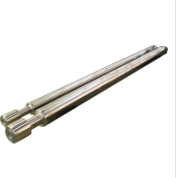Mandrel is a tool used in the production of seamless pipes, which is inserted into the interior of the pipe body and forms a circular hole with rollers to shape the pipe. Mandrels are required for continuous pipe rolling, pipe oblique rolling extension, periodic pipe rolling, top pipe, and cold rolling and cold drawing of pipes.
The Mandrel is a long round rod that participates in the deformation of the pipe material in the deformation zone, just like the top. The difference is that during oblique rolling, the Mandrel moves axially inside the pipe material as it rotates; During longitudinal rolling (continuous tube rolling, periodic tube rolling, top tube), the Mandrel does not rotate but also moves axially with the tube.
On the floating Mandrel and limited motion Mandrel continuous pipe rolling machine (see continuous pipe rolling machine for pipe rolling), the Mandrel is an important tool. In addition to being made of high-strength and high wear resistant materials, they also require high surface quality, such as grinding and heat treatment after turning. The floating Mandrel is very long (up to 30m) and heavy (up to 12t). The length of the limiting Mandrel is slightly shorter, but it requires higher material quality. The Mandrel used for the top pipe should be able to withstand a large pushing force. The Mandrel of the periodic pipe rolling machine has a long heating time during operation. The Mandrels of the diagonal rolling and stretching machine include tension Mandrels, floating Mandrels, limit Mandrels, and retraction Mandrels.
A tension Mandrel is a Mandrel that moves axially at a speed greater than the axial speed of the pipe during operation (see pipe diagonal rolling extension), and exerts tension on the inner surface of the pipe. The retreat type Mandrel is a Mandrel that moves in the opposite direction to the axial direction of the tube, and is subjected to post tension. The requirements for the Mandrel of the diagonal rolling and stretching machine are lower than those of the longitudinal rolling and stretching machine.
The restricted Mandrel has various important uses in the process of pipe rolling, mainly reflected in the following aspects:
l Improving wall thickness accuracy:
The limited motion Mandrel rolling mill ensures the accuracy of pipe wall thickness by controlling the speed of the Mandrel. The speed of the Mandrel should be higher than the biting speed of the first frame and lower than the rolling speed of the first frame, so as to maintain a constant speed throughout the rolling process, avoid the irregularity of metal flow, and reduce the phenomenon of “bamboo knots”.
l Improving the quality of steel pipes:
Due to the relative motion between the Mandrel and the inner surface of the steel pipe, the limited motion Mandrel rolling mill is conducive to the extension of the metal, reduces lateral deformation, and improves the accuracy of the inner and outer surfaces and dimensions of the steel pipe.
l Shorten the process flow:
Compared with the floating Mandrel rolling mill, the limited motion Mandrel rolling mill eliminates the stripping machine, shortens the process flow, increases the final rolling temperature of steel pipes, and saves energy.
Post time: Oct-15-2024





